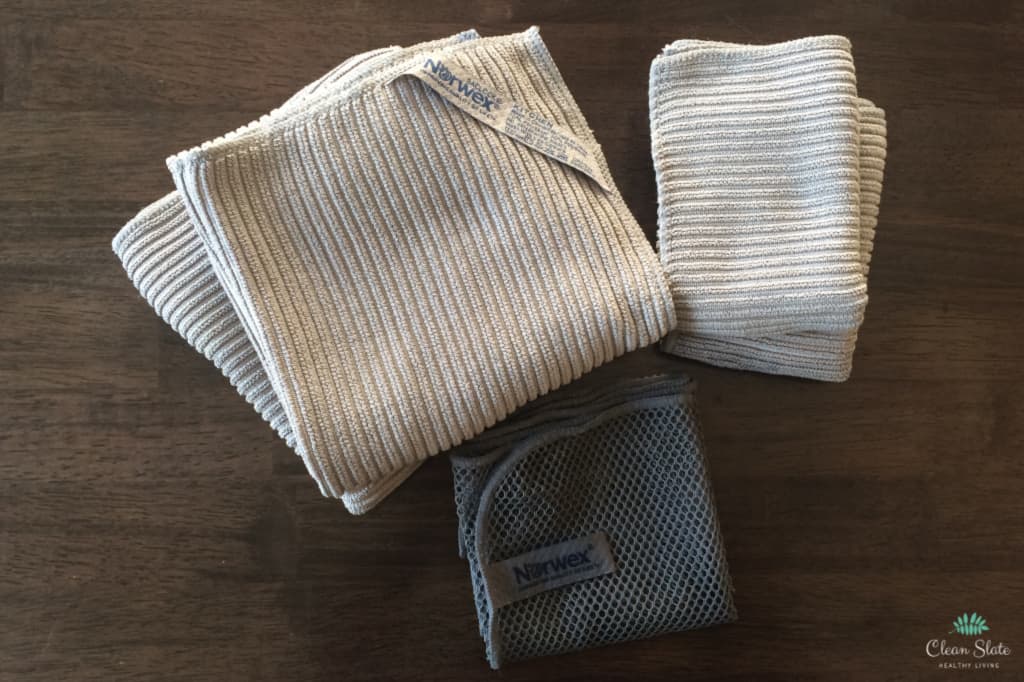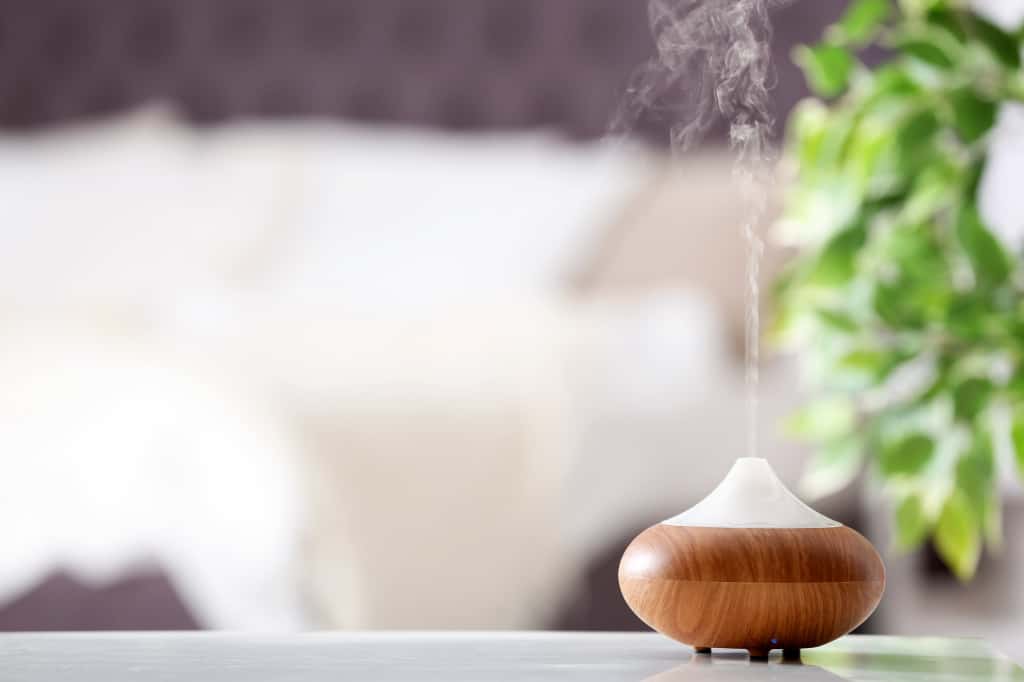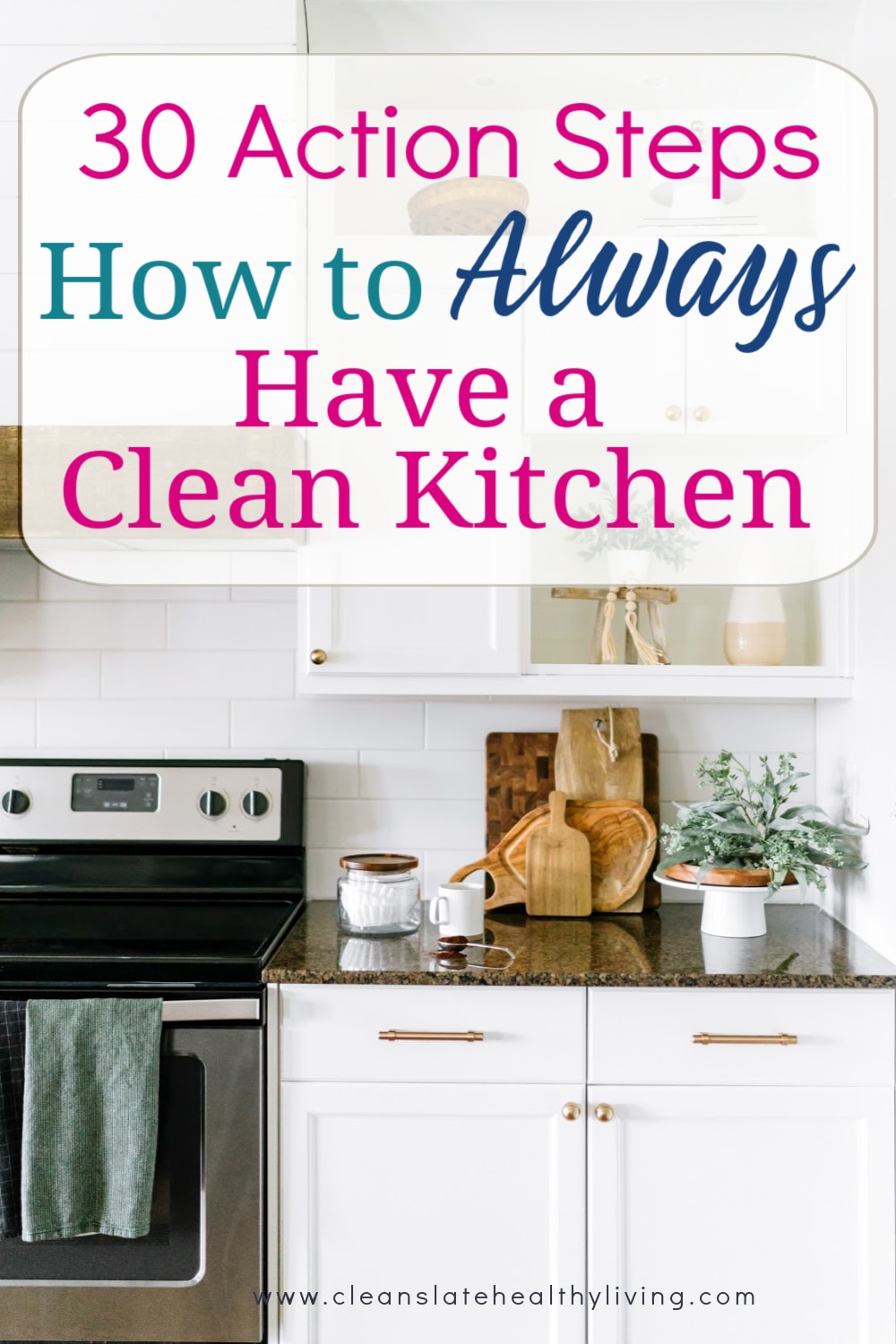There is nothing worse than spending hours preparing a meal only to have piles of dishes in the sink and random ingredients, dishes, and spills covering your countertops. Sometimes the mess looks so daunting you don’t even attempt to clean it. You wake up the next morning only to have to deal with an even bigger mess.
Imagine the possibility of ending your meal preparation with a clean kitchen every night. Wouldn’t it be great if your kitchen was so clean by the time your food was ready that you only had to spend less than 5 minutes cleaning the kitchen after eating? This blog post will give you 30 practical tips to always have a clean kitchen including how to start with a clean kitchen, how to clean as you go, and how to minimize messes with special kitchen tools and gadgets.
Table of Contents
1. Start with a Clean Kitchen
Cooking is more enjoyable and much faster when you start with a clean kitchen. Cooking in a kitchen where everything is messy and scattered everywhere is stressful and time-consuming. Have you ever noticed that when things are left on your kitchen countertops or in the sink they tend to multiply exponentially?
A cluttered space makes a cluttered and stressed-out mind. This is because clutter distracts us, signals to our mind that our work is never done, makes it harder to relax, and gets in the way of productivity. It is scientifically proven that clutter causes anxiety and stress. Psychologist Sherrie Bourg Carter explains, “Messy homes and workspaces leave us feeling anxious, helpless, and overwhelmed.”
One of the worst areas of your home to have cluttered is the kitchen. I find that when my kitchen is cluttered, it takes me much more time to cook and my kitchen ends up messier than when I started.
When I told my 5-year-old that I was writing about how to keep the kitchen clean and clutter-free, she said, “That’s easy, I know how! Stop cooking!” If it were only that easy!
It is very important to always start with a clean kitchen. You should have a clean sink, clean counter tops, and an empty dishwasher. Don’t start cooking until your kitchen is clean. If you start with a clean kitchen you will feel more motivated to keep it clean, and it will be easier to keep clean.

2. Limit Countertop Clutter
Only keep daily use appliances on the countertops; everything else should be put away. This will instantly make your kitchen look cleaner. Clear counters will give you more space for preparing food and will make your kitchen feel less cluttered. Clutter free counters also makes it easier to clean. The more stuff you have out on counters, the more stuff you have to move in order to wipe them down. Make sure everything has a home.
3. Create a Designated Drop Zone
Kitchen counters are often cluttered with things that don’t even belong in the kitchen. When you come in the door after work, have a designated place to put your bag, keys, phone, mail, school papers, etc. Resist the urge to put them on the kitchen counter or table.
4. Start the Day with an Empty Sink and Dishwasher
If you start with an empty sink and dishwasher, it makes it easier to keep your kitchen clean as you are cooking. Make it a habit to either empty the dishwasher the night before or first thing in the morning so you have a place to put all your dirty dishes throughout the day. Resist the urge to put off emptying the dishwasher until later because dishes will start piling up. Every time you use any dishes, immediately rinse them and put them in the dishwasher, or hand wash them and put them away, so you never have dishes sitting in the sink or on the counters.
5. Keep Cabinets, Pantry, and Refrigerator Organized
Keep an organized refrigerator and pantry so you can find things quickly and put them away quickly. When these areas are unorganized, you are more likely to leave items on the counter instead of putting them away. Make sure there is a place for everything and that everything is in its place. Use clear organizing boxes, lazy Susan’s, and glass food containers to keep these areas organized. Make sure your containers holding flour are big enough for measuring cups to fit in.

6. Plan Ahead
Have a plan before you begin cooking. Know what you are making for dinner and read through the entire recipe first so you know exactly what you will need to do. Think of the timing of everything and prep ingredients before you start cooking. Have a plan of how you are going to tackle preparing the food, so you limit the mess you create and use less dishes.
If you know you will have to cut vegetables and meat, cut the vegetables first and then the chicken, and you’ll only have to wash your cutting board and knife once. Choose pots and bowls that are big enough to hold your ingredients. If you’re not sure which size to choose, opt for the bigger one, so you don’t end up needing to get two dirty just because it didn’t fit.
7. Clean as You Go
Cleaning as you go sounds obvious, but it is a habit that needs to be developed as it doesn’t come second nature to most people. Make it a point to avoid leaving piles of dishes to clean after supper.
Develop the habit of putting things away as you use them instead of leaving them to pile up on the countertops. Once you get the hang of cleaning as you go and you realize that you don’t have to spend all night cleaning up after dinner, it becomes easier to maintain this habit.
Here is an example of cleaning as you go. If you are making soup and you cut up carrots, celery, and onion for the soup, when the vegetables are sizzling in the pan wash the cutting board and knife and put it away right away. Continue to prep, clean, and cook until your meal is ready. You will be surprised at how clean your kitchen will be.
8. Utilize Every Second of Wait Time
Utilize every second or minute of wait time to clean. When you are waiting on meat to defrost in the microwave, or water to come to a boil, or food to bake in the oven, CLEAN.
No matter how short the amount of time is, use it for cleaning. Wipe counters, put dishes in the dishwasher, and put ingredients away. You will be amazed at how much you can clean in the 5 minutes it takes to wait for the water to finish coming to a boil.
Also washing dishes as you go will save you even more time later because when you allow your dishes to sit, the food hardens on to the dishes making them more time consuming to clean.
9. Have a Hot Soapy Water Soak Ready in One Side of Sink
Before you begin cooking, fill one side of your sink with hot soapy water and leave the other side of your sink empty. Use the empty side to rinse food off dishes so you don’t get food particles in the soapy water. It’s especially important to rinse dishes with dough, ground meat, and cheese in cold water before putting it in the soapy water.
Use the soapy side to hold dishes until you have a free moment to wash them or put them in the dishwasher. The dishes do not need to soak for long.
If you are too busy to wash something right away and don’t want to have your sink filled with water, spray the dishes with a solution of 2 cups of water, ½ tsp of baking soda, and 1 tsp of dish soap. Then when you do get a moment of free time, the dishes will be easier to clean.

10. Don’t Wash All of Your Dishes
Instead of putting all of your dishes in the sink, separate the dishes that need to be rinsed from the dishes that need to be washed. Things like measuring cups that you just used to scoop up flour or bowls you used to hold vegetables only need to be rinsed with hot water, they do not need to be washed. Rinse, dry, and put these things away as you are cooking.
11. Load and Empty the Dishwasher Properly
It’s frustrating when you go to empty the dishwasher only to find that several dishes are still dirty. To prevent this, load your dishwasher so the fronts of all your dishes are facing the center. This way, they all have access to the soapy water. Alternate silverware pointing up and down, so they all get clean.
It also helps to have a clean and dirty magnet on the front of your dishwasher, so you never have to wonder again if your dishwasher is clean.
When emptying the dishwasher, stack like items together on the countertop above the dishwasher before putting them away. This way you will not have to make so many trips across your kitchen to put items away.
12. Don’t Put Everything in the Dishwasher
Wash dishes as you go instead of putting everything in the dishwasher. Large items take up a lot of room in the dishwasher. Wash and dry these by hand and put them away immediately. Large items are usually the ones that pile up in the kitchen so taking care of them right away can help prevent this.
13. Use the Norwex Dish Cloth
Throw away bacteria-laden sponges. Instead, use the Norwex dishcloth for cleaning dishes. When I first started using the Norwex dishcloth, I hated it. It was so large and difficult to use. When I learned how to properly use it, it became my favorite product for washing dishes. This cloth easily scrubs food off dishes, rinses completely clean, and dries quickly to prevent smelly bacteria.
To use the Norwex dishcloth, fold it in a triangle, and then tie the bottom two corners into a knot. Then tie the corners into a knot again. This will make the cloth into a ball shape.
Squirt the soap in the middle of the ball and scrub all your dishes. When you are done, untie the cloth and rinse it. All the food particles will fall through the holes. You can also lay it flat over your dishes on the top rack of your dishwasher to get a deeper clean. Now you’ll never need to buy another sponge again!

14. Use Microfiber Towels
Along with the Norwex dishcloth, another kitchen essential that I use daily is the Norwex kitchen towel and cloth. These towels are ultra-absorbent and fast drying. They dry dishes and hands so much better than my other dish towels. They are embedded with BackLock- (silver) that self purifies and inhibits odors from bacteria and mildew within 24 hours so it is ready to be used again. You can use the same towel all week and your towel will not smell bad. I have used the same kitchen towel for up to 2 weeks and it still smells fresh when I go to wash it. I replaced all my kitchen towels with just 3 Norwex towels.
I use the Norwex kitchen cloth to wipe down my counters. The ribs in the cloth hold onto crumbs and easily wipe up messes and grease with only water. They are easy to rinse out and are self-purifying so I can use the same cloth all week.
I no longer have the issue of having musty smelling towels and I have much less laundry to do each week.
15. Limit Measuring Messes
Do any messy measuring or pouring over the sink, so you don’t get flour or other spills on your counters. Oil your measuring spoons before measuring sticky ingredients like honey, maple syrup, and nut butters. It will come straight off the spoon and will make cleaning up a breeze.
16. Use a Scrap Bowl
Instead of throwing scraps on the counter or in your sink, use a scrap bowl or over the cabinet trashcan to collect food scraps as you are cutting. Put a plastic produce bag or grocery bag in the bowl so you don’t even have to wash the bowl afterward.
17. Clean Spills Immediately
Clean spills right away so you don’t have more work scrubbing later. Dried spills take much longer to clean. If you drop something on the floor, pick it up right away and wipe the floor. Clean microwave, stovetop, and oven spills before they get baked on.
If you already have a messy microwave, try putting a bowl with 2 cups of water, 2 TB vinegar, and 2 drops of essential oils in the microwave on high for 7 minutes. The steam will make it incredibly easy to wipe all the grease and food stains away.
18. Give Kitchen Surfaces and Small Appliances a Quick Wipe Down After Use
Give small kitchen appliances a quick wipe down every time you use them. This will eliminate the need for deep cleaning these items later. Wipe down the handles and the fronts of your refrigerator, dishwasher, and stove. Quickly wipe down counters as well. It will only take a few seconds, but it will make your kitchen look really clean.

19. Minimize Odors
An important part to always have a clean kitchen is having a fresh-smelling kitchen. Minimize odors by using an air purifier in the kitchen, turning on the vent fan while cooking, and emptying trash regularly.
One of the spots that tend to get stinky is the garbage disposal. Clean your garbage disposal by grinding up ice cubes made from vinegar and essential oils.
You can mask bad smells by using an essential oil diffuser or by simmering a pot of water with citrus peels, cinnamon sticks, or cloves.
20. Keep a Small Recycling Bin Nearby
One of the things that clutters our counters are recycled materials that need to be rinsed out and put in the recycling bin. Our city recycling bin is kept outside, so having a separate smaller recycling bin in the pantry or under the sink really saves time. Rinse recycled items right away and put them in a dedicated spot that’s out of sight until you are ready to put them in your city recycling bin.

21. Develop a Nightly Kitchen Cleaning Routine
Develop a nightly kitchen cleaning routine that takes 20 minutes or less. Involve your family and give each person jobs to cut down drastically on time.
Nightly kitchen cleaning routines can include clearing off the table, putting leftovers away or packing lunches, wiping down the kitchen table and counters, wiping down the stovetop, washing any remaining dishes, cleaning the sink, starting the dishwasher, sweeping the floors, taking out the trash and recycling, or even spraying the floor with a vinegar/water/essential oil solution and quickly mopping it.
Whatever you choose to include in your nightly routine, follow the same order and do the same thing each night and you will notice that cleaning the kitchen will be faster because your routine will become second nature to you and requires less thinking.
Just like restaurants clean their kitchen and dining areas to prepare for the next day, you are essentially shutting down your kitchen, so it is ready for the next day.
22. Use Tools to Lessen the Mess to Always Have a Clean Kitchen
Usually when cooking, using too many tools just creates more dishes to wash. The 7 tools listed below are well worth the time it will take to wash them because they prevent bigger messes from happening.
23. Use a Splatter Guard or Splatter Screen
You can reduce splattering oil by patting food dry, but grease still seems to get everywhere no matter what. End the problem of splatter from grease and sauces by using a splatter guard or a splatter screen. These two tools can save you so much time in cleaning your stovetop, backsplash, and floor from unwanted splatters. These tools keep most of the grease in while still letting the steam out.
24. Don’t Put Dirty Spoons on the Counter
Instead of putting a dirty spoon straight on the counter, use a plate or a jar to hold your spoon. Another option is to use a flexible pot clip to stick to the side of your pots and pans. Pot clips allow you to rest your utensils over the pot while you are cooking. You can easily stir the sauce or soup in your pot and then put the spoon right back over the sauce on the pot, so the drips go right back in the pot.
25. Use Baking Sheet Liners
Baking sheets can be a pain to clean, especially when food gets baked on to them. Instead of putting your food directly on your baking sheet, use parchment baking sheets as liners. When your food is done, you can simply throw away the parchment paper and your pan will likely only need to be rinsed off. You can also use a silicone baking mat. Don’t use aluminum foil because the aluminum in the foil can leach into your food.
26. Use a Roll Up Dish Mat
Instead of using a bulky drying rack or a musty towel to hold dishes while they air dry, use an over the sink drying mat. You lay it across the side of your sink that you aren’t using. As your dishes dry, all the water will drip into the sink. The mat rolls up so when you aren’t using it, it can easily be stored.
27. Use Cutting Board Liners
If you do a lot of chopping and have to frequently wash your cutting board or if you have a large cutting board that you hate washing, then cutting board liners are for you. The liners fit over your cutting board so your cutting board stays mess-free. They are flexible so they allow you to easily carry and pour all your vegetables into a pan without dropping any. They are also very easy to wash by hand or in the dishwasher. I especially like using flexible cutting board liners for cutting meat.
28. Clean Countertops With a Squeegie and Brush Combo
A countertop squeegee and brush makes it easy to wipe spills on the countertops into your sink. It has a squeegee side for liquid spills and a brush side for crumbs. This tool will cut back on the number of paper towels or dish towels you use wiping down your counters.
29. Use a Collapsible Bag Stand
A collapsible bag stand is probably something you never knew you needed! It is incredibly versatile and can do many jobs for you. You can use a bag stand to hold ziplock bags upright and open while you scoop food into them. You can also use it to hold a bag for collecting scraps as you are chopping vegetables. It also works to hold bottles that are air drying.
30. Use Funnels for Pouring
Funnels make it easier to transfer liquids from one container to another without spilling. Look for a set with different sizes for different jobs. You also need to make sure the funnel you are using can endure high heats without leaching plastic into your food so you can pour hot liquids like soups.
Enjoy Your Clean Kitchen!
I hope you find these tips helpful. Once I started incorporating these tips, my kitchen stays clean every night and I have drastically cut down on the amount of time it takes to cook and clean. I never thought it was possible for me to end my meal prep with a clean kitchen every night.
Now that I come home every day to a clean kitchen, cooking is no longer stressful, and it takes much less time. An added benefit is that when I find out someone is coming over, I don’t have to scramble to clean the kitchen. It is already clean!
Do you have any other tips on how to always have a clean kitchen? Share them in the comments section below. Check out my article about how to always have a clean house for more cleaning tips.
Pin For Later:


Leave a Reply